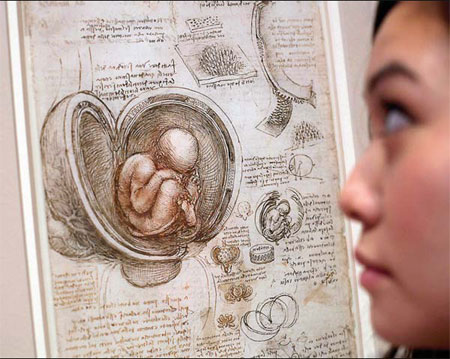5月4日到10月7日,英国白金汉宫的女王美术馆将举办题为“达•芬奇:解剖学家”的展览,将展出著名画家达•芬奇的87幅解剖画作。这些画稿均为英国王室的收藏,至今已有500多年的历史,画稿详细而准确地描绘了人体肌肉和骨骼的结构,以及手、脚、颈、脊椎因肌肉活动所产生的各种姿态。展览负责人表示,这些画稿从未在达•芬奇生前展出过,如果发表的话,达•芬奇就有可能成为当时最伟大的科学家之一。据介绍,达•芬奇在当时共解剖了大约30具人体标本,做了上百幅解剖画稿,不过这些作品直到1900年才被发表并得到科学界的认可。

 |
|
An employee of the Queen's Gallery looks at an ink drawing by Leonardo da Vinci titled Studies of the Foetus in the Womb (around 1510-13) at the "Leonardo da Vinci: Anatomist" exhibition in the gallery of Buckingham Palace, London, on Monday. The display, the largest ever of da Vinci's anatomical works, runs from Friday until Oct 7 and is open to the public. (AP) |
Leonardo da Vinci may be best known for painting the world's most enigmatic smile, but a new exhibition at Buckingham Palace explores the Italian Renaissance painter, sculptor, inventor and scientist's breathtaking anatomical studies of the human body.
"Leonardo da Vinci: Anatomist", which runs from Friday to Oct 7, features 87 anatomical drawings by Leonardo, the largest collection to ever go on show, including a detailed portrayal in red chalk of a child in the breech position and pencil drawings of the human skull.
The body of work, which was never published in the artist's lifetime, would have made Leonardo one of greatest Renaissance scientists to this day, said Martin Clayton, exhibition curator at The Queen's Gallery.
Leonardo's desire to be "true to nature" saw the artist dissect 30 corpses and compile hundreds of sheets of drawings of the human body, but his research stayed among his private papers until 1900, when they were finally published and understood by the scientific world.
"Had Leonardo published, he would have been the most important figure ever to publish on human anatomy and we would regard him now on par with Galileo or Newton," Clayton told Reuters.
"Leonardo has a reputation as a great painter who did a bit of science on the side, almost like a hobby. People think of his flying machine and submarine."
Clayton said the exhibition shows that Leonardo's work as an anatomist was deeply serious, incredibly detailed and hugely important.
The artist's drawing of the cardiovascular system was compiled in several stages, sketched first in red and then black chalk, his fingerprints still visible on the paper.
Francis Well, associate lecturer at the University of Cambridge, said the 500-year-old drawings are still relevant to modern science.
"Examining these drawings of the heart as a group, and indeed reading the notes, it is extraordinary to think that they are now 500 years old and yet they still speak to us in current times in a useful way," Wells said in a news statement.
Leonardo's drawings have been in the possession of the English monarch's Royal Collection since 1690.
"I think people are so seduced by Leonardo's paintings that one will always expect it to be a sell-out exhibition," Clayton added.
"But this exhibition shows the other side of Leonardo. It shows that as well as being a consummate painter, he was also a great scientist."
相关阅读
(Agencies)

(中国日报网英语点津 Helen 编辑)